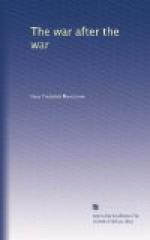War Savings Associations are groups of people who may be clerks in the same office, shop assistants in the same establishments, workers in the same factory or warehouse, people attending the same place of worship, residents in any well-defined locality such as a village or ward of a town, members of a club, the servants in a household: in short, any number of people who are willing to work together. Some have been started with 10 members, others with as many as 500. Up to the first of January nearly 10,000 of these Associations had been formed throughout the Kingdom.
Now came the inspiration that was little short of genius for it enabled the lowliest worker who could only set aside a sixpence a week to become an intimate part of the great British Saving and Investment Scheme. The idea was this:
If one man saves sixpence a week, it would take him thirty-one weeks to get a One Pound War Certificate. But if thirty-one people each save sixpence a week, they can buy a Certificate at once and keep on buying one every week. Thus their savings begin to earn interest immediately. Thus every War Savings Association became a co-operative saving and investment syndicate—a pool of profit.
How are the Certificates distributed? The usual procedure is to draw lots. In a small Association no member is ordinarily permitted to win more than one Certificate in a period of thirty-one weeks, except by special arrangement. Each Association, however, can make its own allotment rules. The value of winning a Certificate the first week is that the winner’s 15/6 will have grown to one pound in four years and a half instead of five. This is broadly the financial advantage gained by being a member of an Association, although the larger reason is that it is more or less compulsory as well as co-operative saving.
Britain is buzzing with these War Savings Associations. You find them in the mobilisation camps, on the training ships, on the grim grey fighters of the Grand Fleet, even in the trenches up against the battle line. The London telephone girls have their own organisation: sales forces of large commercial houses are grouped in thrift units: there are saving battalions in most of the munition works, and so it goes. In many of the big mercantile establishments that have Associations, the weekly drawings of Certificates with all their elements of chance and profits are exciting events.
Many Britishers shy at co-operation. For example, they like to save “on their own.” To meet this desire, the War Savings Committee devised an individual saving and investment plan which begins with a penny, that is two cents. Any person can go to the Treasurer of a War Savings Association and get a blank stamp book. Each penny that he deposits is marked with a lead pencil cross in a blank square. When six of these marks are recorded, a sixpenny stamp is pasted on the blank space. As soon as the book contains thirty-one stamps it is exchanged for a War Savings Certificate.




